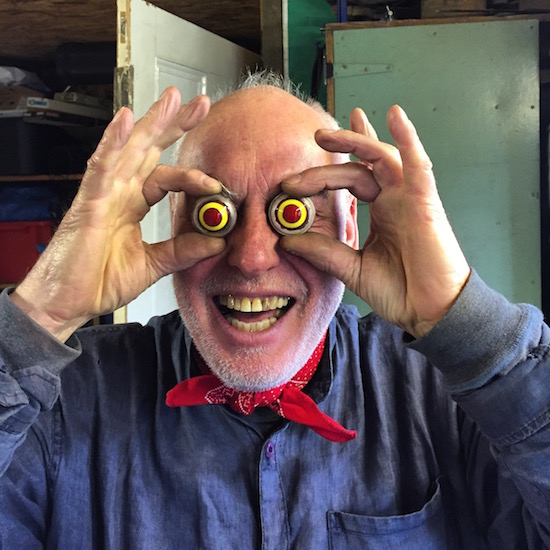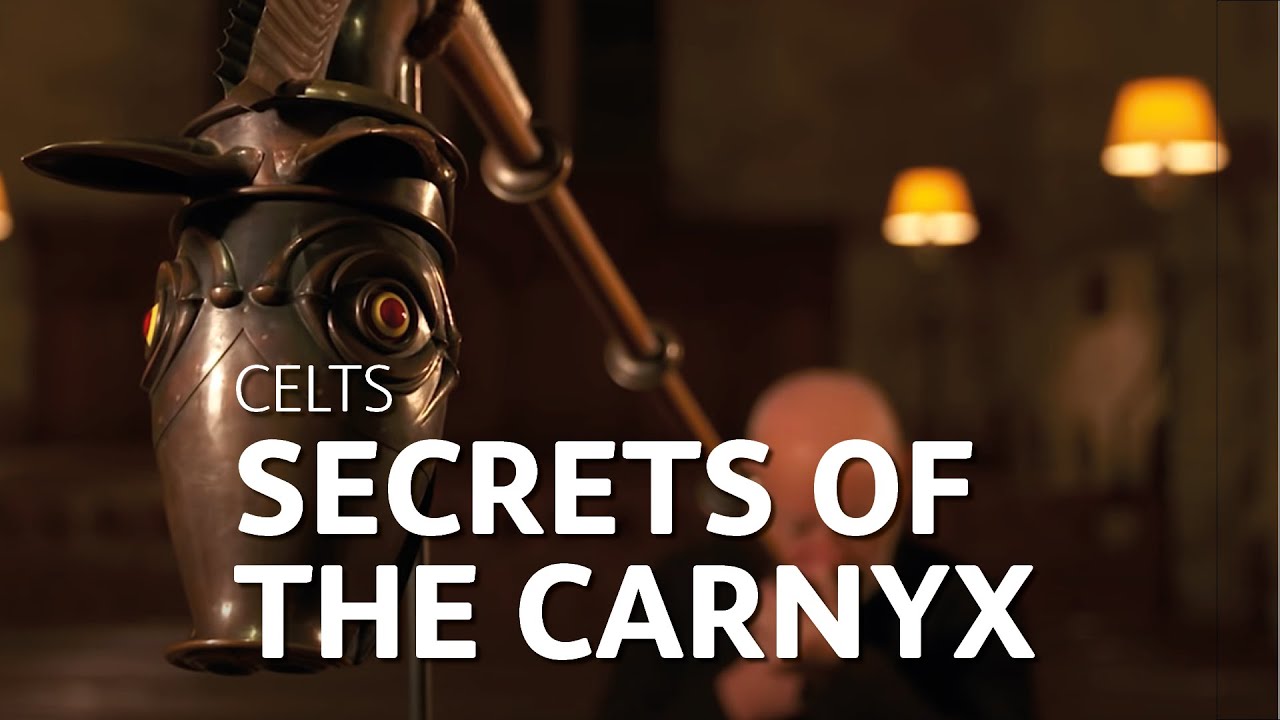The Sunday lunchtime peace and quiet of the Glasgow commuter town of Lenzie is shattered by loud, metallic parps, birds scattering from mossy roofs. In the garden adjoining his home and workshop, silversmith John Creed is blowing heartily into his replica of the Iron Age Loughnashade horn, an s-shaped tapered bronze tube capped with a decorative disk. It’s Creed’s third ancient horn since he was recruited by archaeologist Fraser Hunter in the early 90s to work on a reconstruction of a 2000-year-old zoomorphic instrument known as the carnyx. The fearsome prototype, a 1.6-metre-tall pipe topped with a stylised bronze boar’s head complete with jagged mane and a red tongue wagging menacingly in its jaw, lurks in Creed’s office, peering out from above a grandfather clock.
Creed’s work on the carnyx was one of the first of a number of projects recreating ancient instruments to better understand oral cultures in which sound would have had as much, if not more, significance than the visual. In 2013 these disparate groups, working on anything from 40,0000-year-old flutes made from vulture wing bones to Roman lyres, were united in the European Music Archeology Project (EMAP) an EU-backed £3.5 million programme of research, releases, concerts and a touring exhibition. Dr Rupert Till of Huddersfield University, producer of EMAP recordings including an album of carnyx music called Dragon Voices, explains that the organisation’s driving philosophy is to prove that "there were huge commonalities between cultures. It shows how European we are". In this strange time of Brexit and rising nationalism and insularity, these ancients instruments have a very modern message.
At EMAP’s From The Cave To The Rave concert in Glasgow, the carnyx was joined by instruments from the past 40,000 years, including deer antler percussion, bone flutes, conch shells, pipes copied from remains found in the ruins at Pompeii, a lyre and another carnyx from Tintignac, France. Some of these instruments haven’t been played to an audience of this size in thousands of years, giving the event an unusual atmosphere somewhere between an Open University lecture and an ahistorical Eurovision Song Contest. The carnyx first appears in the historical record as a war horn, and it certainly sounds intimidating in Glasgow, discordant blasts like the barking of some infernal and mythical beast. Carried and played by trombonist John Kenny, it arrives from the wings of The Royal Glasgow Conservatoire’s stage to gasps from the audience. Goodness knows what Roman conscripts, shivering in some forsaken outpost of the Empire, would have felt when it honked into view.
John Creed designed and built this carnyx in his Lenzie workshop using sketches of the fragments dug up in Deskford, Scotland in 1816, as well as evidence from Roman and Celtic illustrations. Key was a depiction of three men playing it on the side of the Gundestrup cauldron, the central artefact at the British Museum’s Celts exhibition. John Kenny’s insight was vital for understanding how the carnyx could become a working instrument rather than mere museum exhibit. The bronze boar head was not intended just to spook enemies, but also to make its throaty sound radiate, in the same way that our own voices do from the skull’s nasal and oral cavities.

The carnyx head in John Creed’s workshop
Following Kenny’s advice, Creed spent 400 hours hammering metal to the delicate thinness that makes for the most powerful resonance. "It’s important people realise that we’re not just 3D printing these things," he says, "there’s real skill involved". The Celts were known for their metalworking abilities, but a close-up of the carnyx and Loughnashade horns in Creed’s workshop reveals just how dextrous they were. The beaten bronze has a delicate grain tangible to the touch, almost as if it were polished wood. The hand-worked detailing on the head is incredibly fine, while the wooden tongue and jaw are finely balanced on thin pieces of bronze and lead, allowing the player to shake the pipe and make a vicious rattle rattling sound.

John Creed with carnyx eyes
"The result was extraordinary," Kenny enthuses, "it springs to life when you put the impulse into it". He found that the carnyx had a five octave range and a versatility that suited it to contemporary situations, from studio recordings to a solo performance before an audience of 65,000 at a Celtic music festival held at the Stade De France in Paris. To write the Dragon Voices album Kenny tried to "evoke ancient mythological or physiological states" but insists that this is in no way an attempt to create an "authentic" reproduction of music long lost to memory, but "a work of contemporary imagination". He admits that he’s not averse to going the extra mile to get in character however: "I’ve wandered around playing the carnyx semi-naked covered in woad". With no musical notation, modern musicians like Kenny are writing and performing interpretations of what these instruments could have sounded like. "Form is function and function is form," he explains, "they were clearly used for different purposes in different places". It’s thought, for example, that the brightly-polished serpent-headed Tintignac carnyx had a non-martial, sacred purpose.
At the Cave To The Rave concert it’s played in a duet with its Deskford cousin by John Kenny accompanied by his son, recently returned from playing trombone as part of Peter Andre’s touring band. Their collaboration feels intriguingly fresh, while much of the Dragon Voices record, with track titles like ‘Dance Of Herne’ and ‘After The Hunt’, sounds like other-worldly free-jazz. Kenny himself says that this is contemporary music that just happens to be played on very old designs, and insists that we shouldn’t see his carnyx-playing predecessors as primitive. "An object like this would have been in the hands of a select group of people who could do all sorts of things I haven’t thought of because they’re not in my culture," he says, adding that the musicians would have been his superiors. "They’d have been in trouble if they didn’t do it properly – I wouldn’t like to be a carnyx player working for a Celtic chieftan who had no qualms about cutting people’s heads off and hanging them beneath his chariot. If I make a mistake all that happens is I don’t get booked again!"
Although the first Carnyx reconstruction was funded by the National Museums Of Scotland and a whisky distillery, Kenny takes umbrage at those who try to co-opt these ancient instruments as symbols of national pride. They were first played long before any European nations existed, and many were used by people from across tribal divides. The carnyx, for instance, was played by the Dacians as well as the Celts, who themselves were far from a homogenous people. The hope is that, even if they disturb the Sunday roasts of John Creed’s neighbours, these surprisingly modern-sounding horns, flutes and pipes might be used to connect people, just as they did over thousands of years of European history. "You can imagine groups of people sitting down, slightly unsure of each other, and playing music together on instruments that were quite similar," says Rupert Till, "it would have been a powerful way for them to feel safe." Indeed, there’s a strong sense among everyone involved in EMAP that their work has particular modern significance during the migrant crisis and strife over Brexit. As John Kenny says, "It has taken European collaboration to make the project come to life. Isn’t that a wonderful symbol, right at the moment?"
For more on the European Music Archeology Project go here. This piece was brought to you with the assistance of Bang & Olufsen



